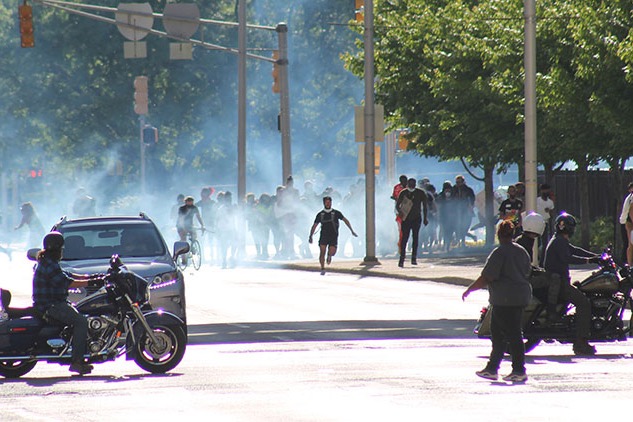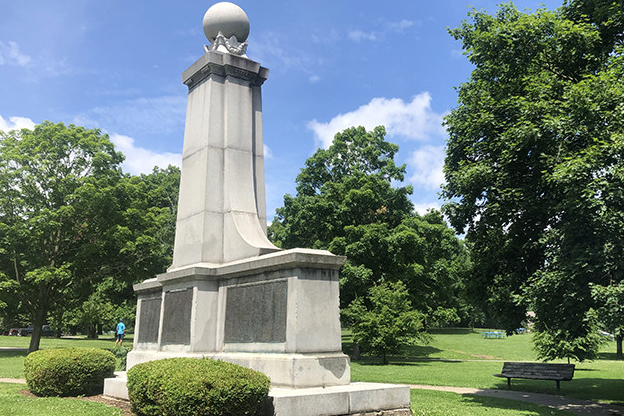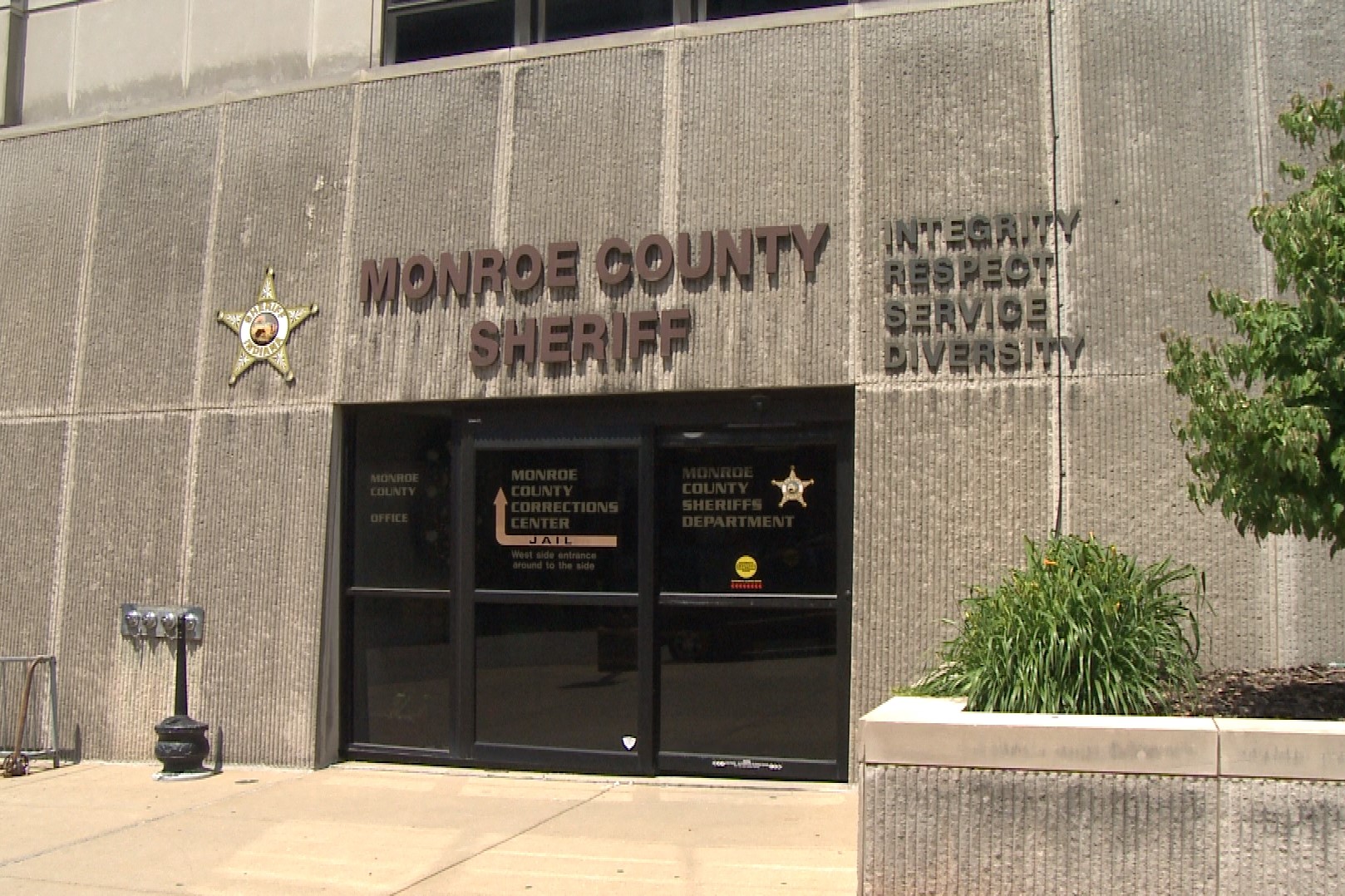
Demonstrators flee tear gas in Indianapolis. (Lauren Chapman/IPB News)
The use of tear gas as a crowd-control technique is gaining attention this week after several incidents during protests against police brutality.
Indianapolis Metropolitan Police Chief Randal Taylor apologized after his officers used tear gas on a peaceful demonstration on Sunday in downtown Indy. A day earlier in Fort Wayne, a young man lost his eye after being struck in the face with a tear-gas canister.
Police have fired tear gas at protesters in Downtown Fort Wayne for the 2nd day. Our @michaelkuhnnews was live when the canisters were shot. pic.twitter.com/PEWRYzaSuS
— WANE 15 (@wane15) May 30, 2020
In addition to the usual risks of tear gas, experts fear it may be spreading the coronavirus.
“Say they were sprayed with pepper spray or with tear gas. All of a sudden they’re going to cough. And we know that coughing is much more of an efficient way of spreading the virus,” Peter Chin-Hong, an infectious disease specialist at the University of California — San Francisco, said Thursday. “Added to that, when someone gets sprayed with this, they're screaming, shouting. That also can project the virus.”
Chin-Hong is one of hundreds of health professionals and community leaders calling on police to stop using tear gas or other irritants that could make the respiratory tract more susceptible to infection, exacerbate inflammation, or induce coughing.
In a joint letter, the experts are urging authorities to maintain distance from protesters and to avoid arresting people or detaining them in confined spaces like jails or police vans.
They also point out that the pandemic is disproportionately harming Black communities.
How might the use of tear gas at protests impact the spread of the coronavirus?
I'll start off by talking about two groups of people and the risk of tear gas in those two groups.
The first is somebody who might be infected with COVID-19 but they are asymptomatic, which has been a feature of this pandemic. People can spread infection without knowing it. Say they were sprayed with pepper spray or with tear gas. All of a sudden they’re going to cough. And we know that coughing is much more of an efficient way of spreading the virus because the virus travels in these droplets. And if they were asymptomatic — no symptoms or no coughing — they probably wouldn't be as efficiently transmitting the infection as when they were coughing. Added to that, when someone gets sprayed with this, they're screaming, shouting. That also can project the virus. That's called aerosolization — like when you have a can of hairspray and you give those droplets superpowers. They can travel further. Outside, that's not usually a problem. But when you're standing next to a group of people who are there for hours, that small risk actually adds up over time. So I think that group of people, who might have COVID-19, they may be not symptomatic. Also, when they get sprayed, they're going to take the mask off and be able to project that virus further.
Now take the people who are not infected. They get sprayed, and they're going to be touching their face, rubbing their eyes and their nose and their mouth. And they don't have a lot of hand sanitizer or places to wash their hands. They've been touching a lot of different things, a lot of people have been touching the same objects, and all of a sudden they bring that potential virus to their nose and mouth — rubbing it because it's really irritating.
Another question is how tear gas itself might make people more susceptible.
The other issue is a little bit more theoretical. But there is the biological plausibility. A nose and a mouth are set up to sort of ward off the evils of the world. They act like the ‘inside skin,’ so to speak. Like when you get burned as on the outside, you can get infected on your skin because all of the sudden, your barriers to the outside world get disrupted. So, similarly, when you get inflamed on the inside, we normally have a thin layer of moisture and all these nose hairs and cilia. And they’re kind of beating rhythmically to push off particles and things like that. When you get it inflamed, they get immobilized and that barrier is disrupted. There's actually some evidence from a few years ago, showing that people who get sprayed are actually at risk for getting respiratory viruses like influenza. Maybe two times the average compared to people who haven't been sprayed. So, we just make that leap to think that with COVID-19 that risk is going to similarly increase because you're disrupting that barrier.
So there are studies showing tear gas can have these effects? I know of one paper on the consequences of exposure in the West Bank.
There’s studies in two groups of people with tear gas for health consequences. I mean, the literature isn't too robust. But there's a group that looked at the acute effects of one-time spraying and infection after that. And then there's more long-term consequences for people who get repeated spraying. And those are less infectious, but they're more like chronic bronchitis, inflammation that goes up over time. And then apart from that, you have all the usual stuff you can imagine on the CDC website. Cataracts and eye stuff. That's not infectious. We've been focused on the COVID-19 stuff. But there's a host of other health problems that you can get as well from these irritants. I mean, it's not a great literature, but it makes sense from biology. And there is a study supporting that hypothesis. So, it’s not far out.
And the other thing is these things that are in tear gas, particulate matter. So, it's almost like pollution. It's like someone blowing smoke into your lungs constantly. So, that's like the non-infectious risk over time, particularly in the West Bank situation. People are getting sprayed and the community is getting exposed over and over again. That’s almost like pollution, right? So it's going to have those effects over time in that population, depending on the exposure risk. And there's one in Turkey, in a Turkish population, that gets quoted a lot. But it makes sense to somebody in health sciences that this would happen. Certainly even with the immediate effects, we all have been ingrained now with what not to do to increase the risk of COVID-19, which is touch your face or cough. But that's what those irritants are designed to make you do. So, you know, it's kind of like the perfect storm.
And that’s why you’re helping promote this letter by health professionals.
Yeah. It arose from the University of Washington from a few colleagues of mine. They’re all infectious disease doctors. And I would say even before all of this, this idea of harm reduction is something we do in infectious disease all the time. Say, someone is injecting drugs, and we want to decrease the risk of HIV acquisition or Hepatitis C acquisition. We don't say, ‘Don't use drugs.’ We say, ‘If you want to use it, here are ways to keep you safe. Don't share needles; you can go to a needle exchange.’ So, that idea of harm reduction, that ethos, is what we want to extend to this scenario. We know that people want to go and protest. In fact, we very much believe that people should have their voices heard during this time. And we just wanted people to be safe and know the risks and to keep themselves as safe as possible.
They asked me to help them, look at the science, edit the letter if I wanted to. And they asked me to help them amplify their voices. They knew I've been outspoken about other aspects of COVID-19, and throughout this pandemic. Things like PPE, hate speech against Asian-Americans, remdesivir distribution by the government. There were so many things that happened during this pandemic that made me very puzzled and confused. And so that was the impetus, and this was the melding of my interests in social justice as well as infectious diseases. And they kind of came together with this. So we wanted to bring on knowledge in infectious disease and in COVID-19 and apply it to people's rights. And we want to encourage people to go out there and have their voices heard, to participate, to show up to demonstrate because it's so important for our country.
And you’re collectively calling for the police to stop using tear gas on those protest.
Yeah. I mean, it is not something that the Geneva Convention wants people to do anyway. People continue to use it. I'm not an expert in tear gas, but from what I understand from people who've studied criminal justice and so on, there's no great evidence that tear gas actually does what it's supposed to do, after decades of research in terms of crowd dispersal.
Certainly from the health lens, I and my colleagues are concerned that it's just going to amplify the risk of COVID-19. We're still in the middle of a raging epidemic. There's different risks in different cities and the people affected the most are minority populations in terms of morbidity and mortality. So it's something we've felt very strongly about in terms of getting that message across. We did want to engage with law enforcement and let them know about these risks and try to have them think about a discussion and mitigating the risk.
What kind of reception is the call getting from people in law enforcement?
We haven't really heard very much from law enforcement. We've heard that people are discussing it. Yesterday in Oakland, California, a councilman had seen the petition, and some lawmakers. They were petitioning the mayor of Oakland to exert some influence on law enforcement to not use tear gas. So that was actually very heartwarming because it showed that the initiative was was being seen by people, and people understood these biological and health risks as another reason not to use these irritants.
What else should people know about COVID-10 and the demonstrations?
I'll make two comments. One is that I think it's easy for us to be polarized — not politically only — but polarized in terms of COVID-19 risk. In the beginning, I think everyone was kind of afraid, and everyone was sheltering in place and listening to the public health recommendations. But what I've seen over time is that people are tired, understandably so, and anxious to reopen society. But I think what we wanted to do, again, is to meet people where they are. Not to really be polarized or dogmatic and tell people what to do, but to really arm them with the science and information so that they can take their own risks and keep themselves protected as much as possible. So, that's one point.
And I guess the last point is: As we think about this more and more, it is clear that racism is probably one of the most dangerous infectious diseases because it amplifies all these risks. And it's a public health crisis, just like we think about gun violence as a public health risk. That’s what is really exemplified by COVID-19 and these protests.
This interview has been condensed and edited for clarity.










